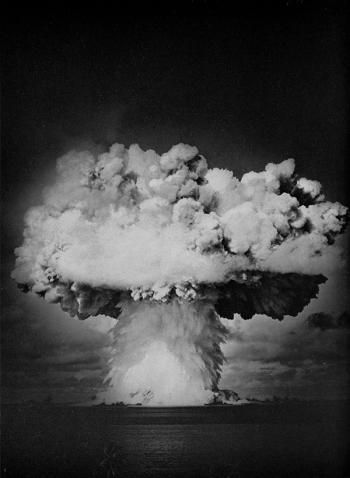Why the 1950s Were da Bomb
More from the Peabody Archives

We had nightmares about mushroom clouds, freaked over fallout. We worried about a Red Menace and theoretical dominos. Sputnik spooked us big time. We had plenty more to fear than fear itself.
These and other unsettling aspects of the 1950s will be illuminated by the second edition of “The Peabody Decades,” a series of screenings that mines the vast Peabody Awards Collection of vintage TV and radio programs at the University of Georgia.
“Drop Out Not Fallout” (7 p.m. Tuesday, October 8, in UGA’s Russell Special Collections Library auditorium) will include clips from such sobering ’50s programming as “The Sun Explodes on Earth,” an episode of a weekly series called “Atomic Primer;” a televised hearing on the Soviet Union’s Sputnik launch; and a discussion on a series called “Prospect” about the future of humanity itself. It’s enough to make you duck and cover all over again.
And yet… the 1950s, during which paranoia percolated like a giant pot of Maxwell House, are remembered with an almost giddy fondness by many of the baby boomers who grew up in their Cold War chill.
An email that an old friend and fellow boomer forwarded to me not long ago, for instance, featured a series of images from the 1950s, many of them doctored to a picture-postcard heavenly-ness:
A filling station with a two-toned ’55 Chevy parked by its plump, friendly pumps.
A gaggle of 12-year-old boys in jeans and plaid shirts playing sandlot baseball without an adult in sight.
A milkman making a home delivery.
A rotary telephone.
An S&H Green Stamp “redemption” center.
Good ol’ Howdy Doody, the original “Cowabunga” kid, in his wooden, freckled glory.
Underneath the photos were captions reminding email recipients of a time when “navels were oranges, and Peyton Place was porn,” when “only girls wore earrings, and three was one too many.”
“If you didn’t grow up in the ’50s,” it concluded, “you missed the greatest time in history.”
So, what’s with the disconnect? Selective memory? A lapse in our synapses?
Shane Hamilton, an associate professor at UGA and the associate director of its Center for Virtual History, said one big factor is that for all the understandable anxiety about nuclear annihilation in America in the 1950s, we were never bombed.
He also noted that the Atomic Energy Commission promoted “positive visions of nuclear power throughout the 1950s: the so-called ‘Atoms for Peace’ initiative and widespread claims that atomic energy would power everything from lawn mowers to automobiles to farm machinery tempered the anxieties to some extent.”
Hamilton’s history department colleague Kirk Willis, an associate professor, also underscored the alternative positives. “In (the comic book) Dagwood Splits the Atom, for instance, we were told that ‘the atom is your buddy,’ a position repeated by the Disney people,” he said. “There was… no single fearful narrative on offer, and with such mixed messages, the impact of fearmongers was less than it might have been.”
Willis, whose courses at UGA have included “Nuclear Culture: Images, Attitudes, Controversies,” said it’s important as well to remember “that the world was not nearly as media-saturated then as now.”
It was “radio, newspapers, magazines, films and just the beginning of TV,” he said. “They did not run all day, every day saturating the planet with the same stories over and over. It was thus possible to live through the 1950s and not be particularly tuned in to news and popular culture.”
Willis also noted that Hollywood and the mass media of the day “were not nearly as skeptical/hostile towards the government as they became post-Watergate and post-Vietnam. The Washington press corps was small and respectful, with no Freedom of Information Act and no particular desire to pass one. The government knew best, many felt.”
“Finally,” Willis said, “no serious nuclear accidents/incidents had taken place yet in the U.S. Power plants were only built at the end of the decade, and the fears of low-level radiation exposure were only just being voiced.
“Perhaps most importantly,’” Hamilton said, “the American economy boomed in the 1950s. Although many minorities did not share in the prosperity, it was a decade in which urban blue-collar workers and suburban white-collar workers made impressive material gains, as American manufacturing firms had relatively little global competition, labor unions bolstered their membership rolls and massive federal government spending fueled job creation and padded corporate profits. Thus, fond memories of the ‘good times’ of the ’50s are clearly tied to the flourishing of the ‘American Dream’ in the era.”
Yet another part of the explanation may be that Americans of the era deflated fears with a sense of gallows humor. In the half hour before the start of the “Drop Out, Not Fallout” screening, decade-themed refreshments will be served. The snacks will include a candy item introduced in 1954 and still popular today.
If you attend, by all means help yourself to some Atomic Fireballs.
Author’s note: The “Drop Out, Not Fallout” program is admission-free and open to the general public as well as UGA students, faculty and staff. The clips will be followed by a discussion of the 1950s led by noted Georgia journalist and editor Millard Grimes (UGA ’51).









comments